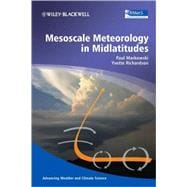
What is included with this book?
Paul M. Markowski is an American meteorologist and leading expert on tornadogenesis and the forecasting of supercells and tornadoes. He was a principal investigator for the IHOP, PAMREX, and VORTEX2 field projects and, with Joshua Wurman, Howard Bluestein, et al., was on the VORTEX2 Steering Committee.
Yvette Richardson is the author of Mesoscale Meteorology in Midlatitudes, published by Wiley.
| Series Foreward | p. xi |
| Preface | p. xiii |
| Acknowledgments | p. xv |
| List of Symbols | p. xvii |
| General Principles | p. 1 |
| What is the Mesoscale? | p. 3 |
| Space and time scales | p. 3 |
| Dynamical distinctions between the mesoscale and synoptic scale | p. 5 |
| Basic Equations and Tools | p. 11 |
| Thermodynamics | p. 11 |
| Mass conservation | p. 16 |
| Momentum equations | p. 17 |
| Vorticity and circulation | p. 21 |
| Pressure perturbations | p. 25 |
| Thermodynamic diagrams | p. 32 |
| Hodographs | p. 34 |
| Mesoscale Instabilities | p. 41 |
| Static instability | p. 41 |
| Centrifugal instability | p. 48 |
| Inertial instability | p. 49 |
| Symmetric instability | p. 53 |
| Shear instability | p. 58 |
| Lower Tropospheric Mesoscale Phenomena | p. 71 |
| The Boundary Layer | p. 73 |
| The nature of turbulent fluxes | p. 73 |
| Surface energy budget | p. 82 |
| Structure and evolution of the boundary layer | p. 83 |
| Boundary layer convection | p. 88 |
| Lake-effect convection | p. 93 |
| Urban boundary layers | p. 103 |
| The nocturnal low-Level wind maximum | p. 105 |
| Air Mass Boundaries | p. 115 |
| Synoptic fronts | p. 117 |
| Drylines | p. 132 |
| Outflow boundaries | p. 140 |
| Mesoscale boundaries originating from differential surface heating | p. 149 |
| Mesoscale Gravity Waves | p. 161 |
| Basic wave conventions | p. 161 |
| Internal gravity wave dynamics | p. 165 |
| Wave reflection | p. 170 |
| Critical levels | p. 172 |
| Structure and environments of ducted mesoscale gravity waves | p. 173 |
| Bores | p. 175 |
| Deep Moist Convection | p. 181 |
| Convection Initiation | p. 183 |
| Requisites for convection initiation and the role of larger scales | p. 183 |
| Mesoscale complexities of convection initiation | p. 189 |
| Moisture convergence | p. 195 |
| Elevated convection | p. 197 |
| Organization of Isolated Convection | p. 201 |
| Rote of vertical wind shear | p. 201 |
| Single-cell convection | p. 206 |
| Multicellular convection | p. 209 |
| Supercellular convection | p. 213 |
| Mesoscale Convective Systems | p. 245 |
| General characteristics | p. 245 |
| Squall line structure | p. 249 |
| Squall line maintenance | p. 253 |
| Rear inflow and bow echoes | p. 260 |
| Mesoscale convective complexes | p. 265 |
| Hazards Associated with Deep Moist Convection | p. 273 |
| Tornadoes | p. 273 |
| Nontornadic, damaging straight-Line winds | p. 292 |
| Hailstorms | p. 306 |
| Flash floods | p. 309 |
| Orographic Mesoscale Phenomena | p. 315 |
| Thermally Forced Winds in Mountainous Terrain | p. 317 |
| Slope winds | p. 317 |
| Valley winds | p. 320 |
| Mountain Waves and Downslope Windstorms | p. 327 |
| Internal gravity waves forced by two-dimensional terrain | p. 327 |
| Gravity waves forced by isolated peaks | p. 332 |
| Downslope windstorms | p. 333 |
| Rotors | p. 342 |
| Blocking of the Wind by Terrain | p. 343 |
| Factors that govern whether air flows over or around a terrain obstacle | p. 343 |
| Orographically trapped cold-air surges | p. 346 |
| Lee vortices | p. 351 |
| Gap flows | p. 358 |
| Appendix | p. 367 |
| A Radar and Its Applications | p. 369 |
| Radar basics | p. 369 |
| Doppler radar principles | p. 371 |
| Applications | p. 374 |
| References | p. 389 |
| Index | p. 399 |
| Table of Contents provided by Ingram. All Rights Reserved. |
The New copy of this book will include any supplemental materials advertised. Please check the title of the book to determine if it should include any access cards, study guides, lab manuals, CDs, etc.
The Used, Rental and eBook copies of this book are not guaranteed to include any supplemental materials. Typically, only the book itself is included. This is true even if the title states it includes any access cards, study guides, lab manuals, CDs, etc.